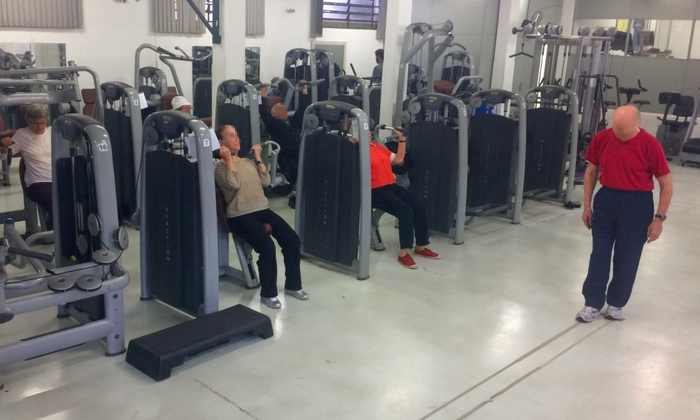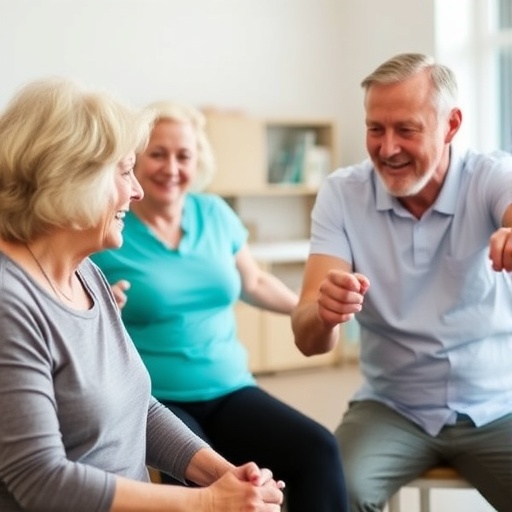Sarcopenia is the decline of skeletal muscle mass with age, leading to loss of muscle strength (to move objects, shake hands etc.) and performance (walking and making other routine movements effectively). It involves chronic inflammation and is associated with cognitive alterations, heart disease and respiratory disorders. In short, it affects the quality of life, reducing independence and increasing the risk of injury, falls and even death.

Credit: Helton de Sá Souza
Sarcopenia is the decline of skeletal muscle mass with age, leading to loss of muscle strength (to move objects, shake hands etc.) and performance (walking and making other routine movements effectively). It involves chronic inflammation and is associated with cognitive alterations, heart disease and respiratory disorders. In short, it affects the quality of life, reducing independence and increasing the risk of injury, falls and even death.
Sarcopenia affects 15% of adults over the age of 60 and 46% of those over 80. Sleep disorders are also common in these age groups. The aging process and sleep disorders are directly associated with increased inflammation. The links between these factors were the focus for a study conducted in Brazil by researchers at the Federal University of São Paulo (UNIFESP) and the University of Viçosa (UFV), Minas Gerais, as reported in article published in the International Journal of Environmental Research and Public Health.
Previous experiments by the group pointed to a correlation between sleep deprivation and muscle atrophy in rats. “Our studies of animal models showed that sleep debt causes muscle atrophy and impairs muscle restoration, in a process that closely resembles sarcopenia involving type 2, or ‘fast-twitch’, muscle fibers,” said Helton de Sá Souza, first author of the article and a professor at UFV’s Department of Physical Education. “Our group had also observed poorer sleep in older people with sarcopenia than older people without this diagnosis.”
Based on this knowledge, the group set out to see if the findings for humans would be similar to those for rats, and how resistance exercise could help address the problem by synchronizing biological rhythms, extending total sleep time, reducing sleep fragmentation, building up muscle mass and strength, and assisting immune system activity by curtailing inflammation.
In the study, 14 adults with an average age of about 75 and diagnosed with sarcopenia performed a resistance exercise training program three times a week for three months. The program consisted of eight exercises for large muscle groups alternating upper and lower limbs (chest, back, shoulders, arms – biceps and triceps – and front and back of thighs). It began with moderate intensity, rising to 80% of maximum force in the last eight weeks.
Fourteen other volunteers in the same age group and also diagnosed with sarcopenia participated only in weekly meetings with different health professionals to increase their knowledge of the lifestyle changes recommended for combating the disease. All 28 participants were assisted throughout the study by physical education professionals, physical therapists, nutritionists and physicians. They were also submitted to a battery of tests, including blood work to assess hormonal, metabolic and inflammatory markers, as well as body composition analysis, physical function assessment and sleep analysis. The results were obtained before the start of the interventions and after they ended so that comparisons could be made.
Results
According to Souza, the main diagnostic marker of age-related sarcopenia is loss of skeletal muscle strength or performance associated with loss of muscle mass. “Loss of muscle mass is inherent in aging, but it becomes a problem in conjunction with reduced function [weakness] or performance [agility, balance etc.],” he said. “If one of these parameters [strength or performance] can be improved, then we’ll be able to lessen the sarcopenia.”
In the study, all metrics of muscle strength improved in the participants submitted to the resistance training program, including handgrip and leg torque measured with a dynamometer.
“We also observed an improvement in objective and subjective sleep quality with the aid of polysomnography, and a reduction in inflammation [based on parameters assessed by blood work],” said Vânia D’Almeida, last author of the article, a professor at UNIFESP’s Department of Psychobiology, and funded by FAPESP.
“Older people with sarcopenia tend to sleep badly, and the study showed that physical training both attenuated their sarcopenia and improved their sleep. This may be due to an increase in two anti-inflammatory cytokines [IL1ra and IL10] associated with muscle metabolism efficiency and possibly with sleep quality,” Souza explained.
Further research is necessary to elucidate how different age groups and genders, with and without sarcopenia, can present specific muscle and sleep responses to potentially anti-inflammatory interventions, such as physical exercise, the authors conclude.
About São Paulo Research Foundation (FAPESP)
The São Paulo Research Foundation (FAPESP) is a public institution with the mission of supporting scientific research in all fields of knowledge by awarding scholarships, fellowships and grants to investigators linked with higher education and research institutions in the State of São Paulo, Brazil. FAPESP is aware that the very best research can only be done by working with the best researchers internationally. Therefore, it has established partnerships with funding agencies, higher education, private companies, and research organizations in other countries known for the quality of their research and has been encouraging scientists funded by its grants to further develop their international collaboration. You can learn more about FAPESP at www.fapesp.br/en and visit FAPESP news agency at www.agencia.fapesp.br/en to keep updated with the latest scientific breakthroughs FAPESP helps achieve through its many programs, awards and research centers. You may also subscribe to FAPESP news agency at http://agencia.fapesp.br/subscribe.
Journal
International Journal of Environmental Research and Public Health
DOI
10.3390/ijerph192316322
Article Title
Resistance Training Improves Sleep and Anti-Inflammatory Parameters in Sarcopenic Older Adults: A Randomized Controlled Trial
Article Publication Date
6-Dec-2022




